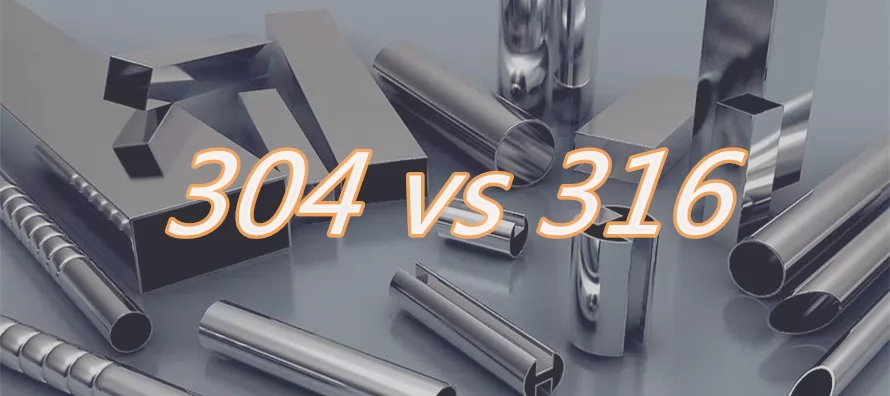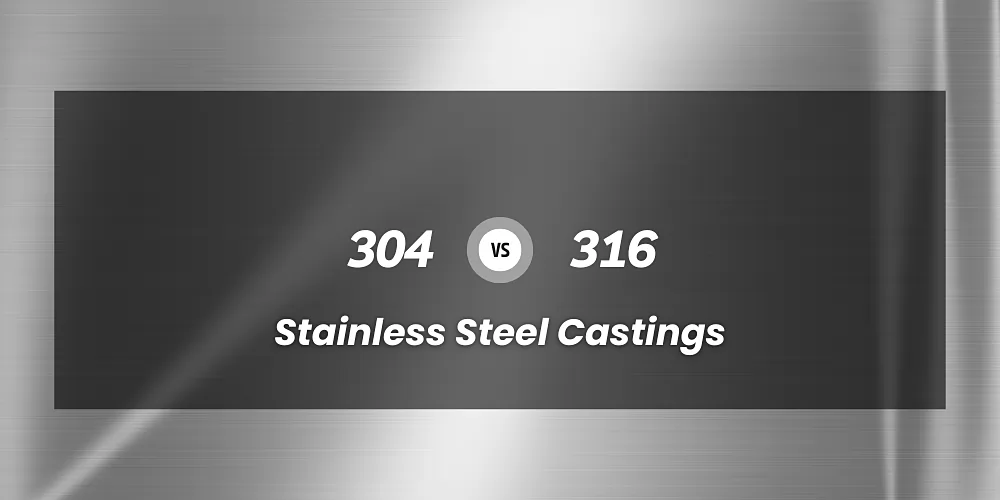
304 and 316 stainless steel castings are widely used in scenes that require corrosion resistance. Of course, although they are called stainless steel castings, wear and corrosion are only a matter of time, but they are still an excellent solution in harsh environments and can provide durable products in many areas.
- What is 304 Stainless Steel Castings
- What is 316 Stainless Steel Castings
- Common Applications for 304 and 316 Stainless Steel Castings
- Difference Between 304 and 316 Stainless Steel Casting
- 304 and 316 Stainless Steel Castings, Which One to Choose?
What is 304 Stainless Steel Castings
304 stainless steel is the most common type of steel. As a widely used steel, it has good corrosion resistance, heat resistance, low-temperature strength, and mechanical properties; it has good hot workability such as stamping and bending, and no heat treatment hardening phenomenon (non-magnetic, Use temperature -196℃~800℃).
Advantages and Disadvantages of 304 Stainless Steel
| Advantages | Disadvantages |
| 1. Excellent corrosion resistance | 1. Lower heat resistance compared to some other stainless steel grades |
| 2. Good strength and toughness | 2. Lower resistance to chloride environments compared to 316 stainless steel |
| 3. Versatile and suitable for various applications | 3. Susceptible to surface pitting in certain corrosive environments |
| 4. Hygienic and easy to clean | 4. Moderate to high initial cost compared to other materials |
| 5. Good weldability and formability | 5. Limited resistance to high-temperature oxidation |
| 6. Can withstand cryogenic temperatures | 6. Lower impact strength compared to some other metals |
| 7. Widely available and cost-effective | 7. Susceptible to stress corrosion cracking in specific conditions |
| 8. Retains properties in a wide temperature range | 8. Not as hard or wear-resistant as some other materials |
Application of 304 Stainless Steel Castings
The Main Application of 304 Stainless Steel Castings
Household products (part of the tableware, cabinets, indoor pipelines, water heaters, boilers, bathtubs)
Auto parts (windshield wipers, mufflers, molded products)
Medical equipment, building materials, chemistry, food industry, agriculture, ship parts, etc.
What is 316 Stainless Steel Castings
Due to the addition of molybdenum to 316 stainless steel, its corrosion resistance, atmospheric corrosion resistance, and high-temperature strength are particularly good. It can be used under harsh conditions; it has excellent work hardening properties (non-magnetic). When choosing austenitic stainless steel for marine applications, 316 stainless steel is generally considered to be one of the most suitable choices
Advantages and Disadvantages of 316 Stainless Steel
| Advantages | Disadvantages |
| 1. Excellent corrosion resistance | 1. Higher cost compared to other stainless steel grades |
| 2. Superior resistance to chloride environments | 2. Lower heat resistance compared to some other materials |
| 3. High strength and toughness | 3. Lower impact strength compared to some other metals |
| 4. Good weldability and formability | 4. Not as hard or wear-resistant as some other materials |
| 5. Retains properties at elevated temperatures | 5. Susceptible to stress corrosion cracking in specific conditions |
| 6. Excellent resistance to pitting and crevice corrosion | |
| 7. Hygienic and easy to clean | |
| 8. Widely available and cost-effective |
Application of 316 Stainless Steel Castings
Equipment used in seawater, chemical, dye, paper, oxalic acid, fertilizer, and other production equipment;
Photography, food industry, coastal facilities, ropes, CD rods, bolts, nuts.
Common Applications for 304 and 316 Stainless Steel Castings
304 Stainless Steel Applications
- Kitchen Equipment: 304 stainless steel is widely used for sinks, countertops, cookware, and cutlery due to its excellent corrosion resistance and durability.
- Food Processing: It is commonly used in tanks, pipes, and processing equipment in the food industry where sanitary conditions are crucial.
- Automotive: This material is ideal for exhaust systems, trim, and molding in vehicles, offering good performance and corrosion resistance.
- Aerospace: Aircraft structural components and fasteners often utilize 304 stainless steel for its strength and lightweight properties.
- Architectural Structures: Building facades, railings, and doors made from 304 stainless steel provide both aesthetic appeal and durability.
- General Industrial: It is used in storage tanks, pressure vessels, and piping systems in various industrial settings due to its strength and resistance to corrosion.
- Consumer Goods: Home appliances and decorative hardware benefit from the use of 304 stainless steel for its sleek appearance and robustness.
316 Stainless Steel Applications
- General Industrial: Chemical processing equipment, industrial machinery, and other equipment that operate in corrosive environments often use 316 stainless steel.
- Marine Applications: Boat fittings, deck hardware, and marine fasteners are typically made from 316 stainless steel due to its excellent resistance to seawater and marine conditions.
- Chemical Processing: 316 stainless steel is ideal for heat exchangers, tanks, and pipelines in chemical plants where high corrosion resistance is necessary.
- Pharmaceutical Manufacturing: Processing vessels and sterilization equipment in the pharmaceutical industry often use 316 stainless steel for its sanitary properties and corrosion resistance.
- Medical Devices: Surgical instruments and orthopedic implants benefit from the use of 316 stainless steel for its biocompatibility and resistance to body fluids.
- Coastal Architectural Structures: Buildings, bridges, and piers in coastal areas use 316 stainless steel to withstand the corrosive effects of seawater and salty air.
- Consumer Goods: High-end consumer products that are exposed to harsh environments, such as luxury watches and jewelry, often incorporate 316 stainless steel.
Difference Between 304 and 316 Stainless Steel Casting

| Aspect | 304 Stainless Steel | 316 Stainless Steel |
| Chemical Composition | 18% chromium, 8% nickel, small amounts of carbon, manganese, and silicon | 16% chromium, 10% nickel, 2-3% molybdenum, small amounts of carbon, manganese, and silicon |
| Corrosion Resistance | Good in atmospheric environments and mild chemicals | Superior, especially in chloride, saline, and chemical environments |
| Strength and Durability | Excellent mechanical properties, durable, versatile | Slightly better strength, higher resistance to pitting and crevice corrosion |
| Applications | Kitchen equipment, food processing, automotive, aerospace, architectural structures, general industrial applications | Marine applications, chemical processing, pharmaceutical manufacturing, medical devices, coastal architectural structures |
| Cost | Generally less expensive | Typically more expensive due to molybdenum content |
| Weldability and Fabrication | Excellent weldability and formability | Excellent weldability and formability, but may require more robust equipment |
| Heat Resistance | Withstands up to 870°C (1600°F) | Withstands up to 927°C (1700°F), better resistance to scaling and carbide precipitation |
| Suitability for Aggressive Environments | Not suitable for environments with high chloride exposure | Ideal for harsh environments, especially those wit |
| Different Chemical Composition | ||
| Grades | 304 | 316 |
| Carbon | C:≤0.08 | C :≤0.08 |
| Manganese | Mn :≤2.0 | Mn:≤2.00 |
| Phosphorus | P :≤0.035 | P :≤0.035 |
| Sulfur | S :≤0.03 | S :≤0.030 |
| Silicon | Si :≤1.0 | Si:≤1.00 |
| Nickel | Ni :8.0~10.5 | Ni:10.00~14.00 |
| Chromium | Cr :18.0~20.0 | Cr:16.00~18.50 |
| Different Performance | ||
| Material | 304 | 316 |
| Tensile strengthσb(MPa) | ≥520 | ≥520 |
| Conditional yield strength σ0.2 (MPa) | ≥205 | ≥205 |
| Elongation δ5 (%) | ≥40 | ≥40 |
| Reduction of area ψ (%) | ≥60 | ≥60 |
| Hardness | ≤187HB,≤90HRB,≤200HV | ≤187HB,≤90HRB,≤200HV |
| Density 20℃ g/cm3 | 7.93 | 7.93 |
| Melting point (℃) | 1398~1454 | 1398-1420 |
304 and 316 Stainless Steel Castings, Which One to Choose?
There is no fixed answer. Generally speaking, if the use environment is salty or acidic, choose AISI316, which is the main and clearest dividing line between the two stainless sheets of steel. What is the working temperature used? The high temperature will accelerate corrosion , so higher grades are more suitable. What is your budget? If AISI 316 is not necessary, AISI 304 will be cheaper. The cost of the former is about 25% higher than the latter.
Besser Foundry is a professional stainless steel investment casting manufacturer in China. We can customize different types of stainless steel castings according to customers' drawings or samples. If you have any inquiry about stainless steel castings, please feel free to contact us!
Related content recommendation
- Complete Guide: What is Stainless Steel Lost Wax Casting 101
- Stainless Steel Foundry Near Me (China, US, UK)
- Top 10 Stainless Steel Investment Casting Companies
- What Are the Types and Grades of Stainless Steel Castings
- Pickling & Passivation of Stainless Steel Castings
- Why Stainless Steel Castings Will Rust



